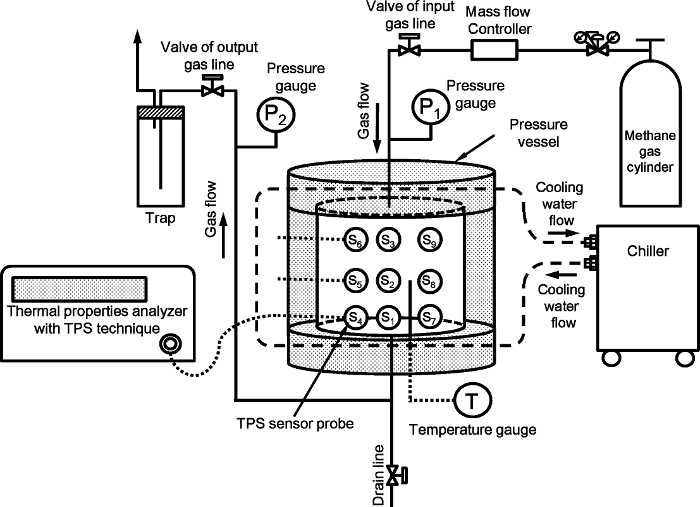過冷却合成砂 - 水 - ガス・メタンハイドレート試料の熱特性を測定するためのプロトコル
Summary
We present a protocol for measuring the thermal properties of synthetic hydrate-bearing sediment samples comprising sand, water, methane, and methane hydrate.
Abstract
Methane hydrates (MHs) are present in large amounts in the ocean floor and permafrost regions. Methane and hydrogen hydrates are being studied as future energy resources and energy storage media. To develop a method for gas production from natural MH-bearing sediments and hydrate-based technologies, it is imperative to understand the thermal properties of gas hydrates.
The thermal properties’ measurements of samples comprising sand, water, methane, and MH are difficult because the melting heat of MH may affect the measurements. To solve this problem, we performed thermal properties’ measurements at supercooled conditions during MH formation. The measurement protocol, calculation method of the saturation change, and tips for thermal constants’ analysis of the sample using transient plane source techniques are described here.
The effect of the formation heat of MH on measurement is very small because the gas hydrate formation rate is very slow. This measurement method can be applied to the thermal properties of the gas hydrate-water-guest gas system, which contains hydrogen, CO2, and ozone hydrates, because the characteristic low formation rate of gas hydrate is not unique to MH. The key point of this method is the low rate of phase transition of the target material. Hence, this method may be applied to other materials having low phase-transition rates.
Introduction
ガスハイドレートは、ケージ1のゲスト分子を含む水素結合水分子のケージ構造を含む結晶性化合物です。海底や永久凍土地域におけるメタンハイドレート(MHS)、大量の興味深い将来のエネルギー資源であるが、地球規模の気候条件2に影響を与えることがあります。
2013年3月には、日本の石油、ガス、および金属鉱物資源機構(株)は、「減圧法」3,4を用いて、東部南海トラフにおける天然MH-ベアリング堆積物からガスを抽出するために、世界初の海洋産出試験を実施しました。
ガスハイドレートは、メタン1、水素5、CO 2 1,6、およびオゾン7のようなガスを保存することができます。したがって、メタンと水素水和物は潜在的なエネルギー貯蔵や輸送媒体として検討されています。大気中に放出されたCO 2排出量、CO 2 sequesを低減するために、深海堆積物中のCO 2ハイドレートが6を検討されている使用してtration。オゾンは、現在、浄水、食品殺菌に使用されます。それは7化学的に不安定であるため、オゾン保全技術の研究が行われています。水和物中のオゾン濃度は、オゾン水や氷7よりもはるかに高いです。
自然MH-ベアリング堆積物や水和物ベースの技術からのガス生産を開発するためには、ガスハイドレートの熱特性を理解することが不可欠です。しかし、ガスハイドレート堆積物の熱特性データとモデル研究は、8が不足しています。
「減圧法は、「水和物の安定性以下の細孔の圧力を減少させることによって堆積物の細孔空間内MHを解離するために使用することができます。このプロセスでは、堆積物の孔空間成分は、水、MH、およびガスに水から、およびMH変わります。熱的特性」の測定MHの融解熱は、測定に影響を与える可能性があるため、後者の条件では困難です。この問題を解決するために、村岡らは MH形成9の間に過冷却状態での熱的特性」の測定を行いました。
このビデオプロトコルでは、我々は過冷却合成砂 – 水 – ガス-MHサンプルの測定方法を説明します。
図1は、人工メタンハイドレート堆積物の熱特性を測定するための実験を示しています。参照9に示すように、セットアップは同じです。システムは、主に、高圧容器、圧力及び温度制御、及び測定システムの熱特性を含みます。高圧容器を140 [mm]の内径および140ミリメートルの高さを有する円筒形ステンレス鋼で構成されています。削除デッドボリュームとその内部容積は2110センチメートル3であり、その圧力限界は15 MPaです。 transie NT面光源(TPS)技術は、熱特性10を測定するために使用されます。 2.001ミリメートルの個々の半径を有するナインTPSプローブは、容器の内側に配置されています。 9プローブ9のレイアウトは、文献9の図2に示されています。 TPSプローブは、ケーブルで熱特性」アナライザに接続し、実験中に手動で切り替えられます。容器内のTPSセンサ接続図、および設定の詳細は、図S1、2、および基準9における支援情報の3に示されています。

図1:人工メタンハイドレート堆積物の熱特性を測定するための実験装置の図を参照9から変更されています。3956fig1large.jpg "ターゲット=" _空白 ">この図の拡大版をご覧になるにはこちらをクリックしてください。
TPSの方法は、各サンプルの熱特性を測定しました。この方法の原理は文献10に記載されています。この方法では、時間依存性の温度上昇は、ΔTaveが 、あります

どこ

0は、センサからの出力電力であり、Wは 、式1において、Rはセンサプローブの半径であり、λは、試料の熱伝導率であり、αは熱拡散率であり、tは、電力供給を開始してからの時間でありますセンサプローブに。D(τ)は無次元時間依存する関数です。τ </EM>(αT/ R)1/2で与えられます。式2において、mは TPSプローブの同心リングの数であり、I 0は、修正されたベッセル関数です。試料の熱伝導率、熱拡散率、比熱を同時に電力がセンサプローブに供給されるように、温度上昇に印加される反転分析によって決定されます。
Protocol
Representative Results
Discussion
測定にMHの生成熱の影響を推定しました。 図3b及び形成H = 52.9 kJのモル-1 MH 14のためのエンタルピーに示すように、MHの形成熱はS Hの変化率の生成物から推定しました。従って、最高温度変化が0.00081°C秒-1でした。これは、5秒の時間間隔の間に1℃から1.5℃の間TPSセンサの温度上昇ΔTcよりはるかに低かったです。詳細評?…
Declarações
The authors have nothing to disclose.
Acknowledgements
本研究は、経済的に日本でのメタンハイドレート資源MH21研究コンソーシアムと経済産業省の国立メタンハイドレート搾取プログラムによってサポートされていました。著者らは、実験とその支援のためのT.前川とS.後藤に感謝したいと思います。
(村岡、M.、Susuki、N.、山口、H.、辻、T.、山本、Y.、エネルギー燃料、29(3)、2015年、1345年から1351年からの許可を得て転載数字、2015、DOI: 10.1021 / ef502350n)。著作権(2015年)アメリカ化学会。
Materials
| TPS thermal probe, Hot disk sensor | Hot Disk AB Co., Sweden | #7577 | Kapton sensor type, sensor radius 2.001 mm |
| Hot disk thermal properties analyzer | Hot Disk AB Co., Sweden | TPS 2500 | |
| Toyoura standard silica sand | Toyoura Keiseki Kogyo Co., Ltd., Japan | N/A | |
| Methane gas ,99.9999% | Tokyo Gas Chemicals Co., Ltd., Japan | N/A | Grade 6N, Volume 47L, Charging pressure 14.7MPa |
| Water Purification System,Elix Advantage 3 | Merck Millipore., U.S. | N/A | 5 MΩ cm (at 25°C) resistivity |
| Vibrating table, Vivratory packer | Sinfonia Technology Co. Ltd., Japan | VGP-60 | |
| Chiller, Thermostatic Bath Circulator | THOMAS KAGAKU Co., Ltd., Japan | TRL-40SP | |
| Coorant, Aurora brine | Tokyo Fine Chemical Co.,Ltd., Japan | N/A | ethylene glycol 71wt% |
| Temparature gage | Nitto Kouatsu., Japan | N/A | Pt 100, sheath-type platinum resistance temperature detector |
| Pressure gage | Kyowa Electronic Instruments., Japan | PG-200 KU | |
| Data logger | KEYENCE., Japan | NR-500 | |
| Mass flow controller | OVAL Co., Japan | F-221S-A-11-11A | Maximum flow 2000 Nml/M, maximum design pressure 19.6 MPa |
Referências
- Sloan, E. D., Koh, C. A. . Clathrate Hydrates of Natural Gases, 3rd ed. , (2007).
- Hatzikiriakos, S. G., Englezos, P. The relationship between global warming and methane gas hydrates in the earth. Chem. Eng. Sci. 48 (23), 3963-3969 (1993).
- Yamamoto, K. Overview and introduction: pressure core-sampling and analyses in the 2012-2013 MH21 offshore test of gas production from methane hydrates in the eastern Nankai Trough. Mar. Petrol. Geol. 66 (Pt 2), 296 (2015).
- Fujii, T., et al. Geological setting and characterization of a methane hydrate reservoir distributed at the first offshore production test site on the Daini-Atsumi Knoll in the eastern Nankai Trough, Japan. Mar. Petrol. Geol. 66 (Pt 2), 310 (2015).
- Mao, W. L., et al. Hydrogen clusters in clathrate hydrate. Science. 297 (5590), 2247-2249 (2002).
- Lee, S., Liang, L., Riestenberg, D., West, O. R., Tsouris, C., Adams, E. CO2 hydrate composite for ocean carbon sequestration. Environ. Sci. Technol. 37 (16), 3701-3708 (2003).
- Muromachi, S., Ohmura, R., Takeya, S., Mori, H. Y. Clathrate Hydrates for Ozone Preservation. J. Phys. Chem. B. 114, 11430-11435 (2010).
- Waite, W. F., et al. Physical properties of hydrate-bearing sediments. Rev. Geophys. 47 (4), (2009).
- Muraoka, M., Susuki, N., Yamaguchi, H., Tsuji, T., Yamamoto, Y. Thermal properties of a supercooled synthetic sand-water-gas-methane hydrate sample. Energy Fuels. 29 (3), 1345-1351 (2015).
- Gustafsson, S. E. Transient plane source techniques for thermal conductivity and thermal diffusivity measurements of solid materials. Rev. Sci. Instrum. 62 (3), 797-804 (1991).
- Sakamoto, Y., Haneda, H., Kawamura, T., Aoki, K., Komai, T., Yamaguchi, T. Experimental Study on a New Enhanced Gas Recovery Method by Nitrogen Injection from a Methane Hydrate Reservoir. J. MMIJ. 123 (8), 386-393 (2007).
- Lee, B. I., Kesler, M. G. A generalized thermodynamic correlation based on three-parameter corresponding states. AIChE J. 21 (3), 510-527 (1975).
- Reid, R. C., Prausnitz, J. M., Poling, B. E. Chapter 3, Unit 3, 7. The properties of gases and liquids. , 47-49 (1987).
- Anderson, G. K. Enthalpy of dissociation and hydration number of methane hydrate from the Clapeyron equation. J. Chem. Thermodyn. 36 (12), 1119-1127 (2004).
- Waite, W. F., deMartin, B. J., Kirby, S. H., Pinkston, J., Ruppel, C. D. Thermal conductivity measurements in porous mixtures of methane hydrate and quartz sand. Geophys. Res. Lett. 29 (24), 82-1-82-4 (2002).
- Kumar, P., Turner, D., Sloan, E. D. Thermal diffusivity measurements of porous methane hydrate and hydrate-sediment mixtures. J. Geophys. Res. 109 (B1), (2004).
- Huang, D., Fan, S. Measuring and modeling thermal conductivity of gas hydrate-bearing sand. J. Geophys. Res. 110 (B1), (2005).

